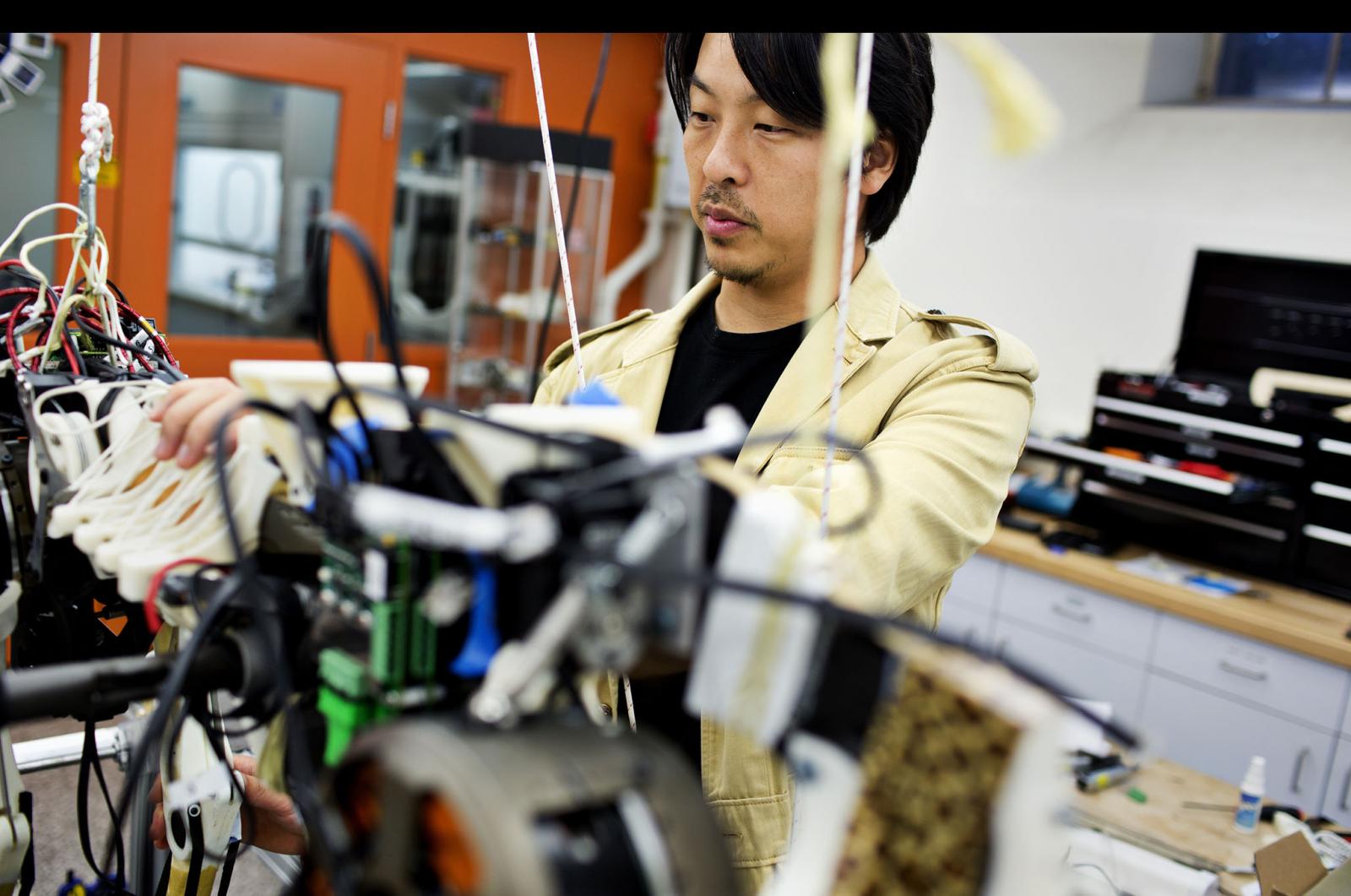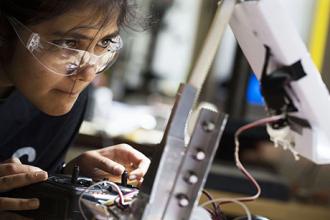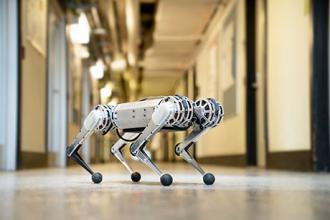
Professor
Sangbae Kim
Professor of Mechanical Engineering
Interests
- Bio-inspired Robotics
- Bipedal Locomotion
- Manipulation
Professor Kim News + Media

The Birth of a Hands-On Education
Design and Manufacturing I, co-taught by Professor Sangbae Kim, is one of the first hands-on classes to teach students not only how to design an object but also how to build it.

Mini cheetah is the first four-legged robot to do a backflip
At just 20 pounds, the robot, which was developed by Associate Professor Sangbae Kim, is designed to be “virtually indestructible,” recovering with little damage, even if a backflip ends in a spill.

Cheetah III robot preps for a role as a first responder
Professor Sangbae Kim is now developing a third generation of his robotic cheetah that's commercially viable and can operate in emergency response environments.
Faculty Details
Education
-
2001
YONSEI UNIVERSITY
B.S. -
2004
STANFORD UNIVERSITY
M.S. -
2008
STANFORD UNIVERSITY
Ph.D.
Research Interests
Robotic Actuators
Machine Learning
Locomotion
Dynamics
Biomechanics
Composite Sensor Fabrication
Bio
Prof. Sangbae Kim, is the director of the Biomimetic Robotics Laboratory and a Professor of Mechanical Engineering at MIT. His research focuses on the bio-inspired robot design by extracting principles from animals. Kim's achievements on bio-inspired robot development include the world's first directional adhesive inspired from gecko lizards, and a climbing robot, Stickybot, that utilizes the directional adhesives to climb smooth surfaces featured in TIME's best inventions in 2006. Recent achievement includes the development of the MIT Cheetah capable of stable outdoor running up to 13mph and autonomous jumping over an obstacles at an efficiency of animals. This achievement was covered by more than 300 media articles. He is a recipient of best paper award from International Conference on Robotics and Automation (2007), King-Sun Fu Memorial Transactions on Robotics (2008) and IEEE/ASME transactions on mechatronics (2016), DARPA Young Faculty Award (2013), NSF CAREER award (2014), and Ruth and Joel Spira Award for Distinguished Teaching (2015).
Honors + Awards
- 2019, Defense Science Study Group
- 2016, Best paper award, IEEE/ASME Transactions on Mechatronics
- 2015, Ruth and Joel Spira Award for Distinguished Teaching, SoE, MIT
- 2014, Faculty Early Career Development (CAREER) Award
- 2013, Young Faculty Award (YFA), Defense Advanced Research Projects Agency
- 2010, Esther and Harold E. Edgerton Career Development Chair
- 2008, King-Sun Fu Memorial Best Transactions on Robotics Paper Award (first Author)
- 2007, Best Student Paper Award and Best conference paper finalist IEEE International Conference in Robotics and Automation 2007 (first author)
- 2006, Best video award, IEEE International Conference in Robotics and Automation 2006 (second author)
- 2006, TIME Magazine's Best Inventions of 2006
Memberships
- Defense Science Study Group, 2020-2021
- IEEE, Robotics and Automation
- American Society of Mechanical Engineering
Professional Service
- Program Committee, Robotics: Science and systems (Jan. 2010 - June. 2010)
- NSF proposal review panel (Robust Intelligence, Feb 2010)
- NSF proposal review panel (IGERT , Jun 2010)
- Associate Editor, the Int. Conf. of Robotics and Automation (Sept. 2010 - Nov. 2010)
- Associate Editor, the Int. Conf. of Robotics and Automation (Sept. 2011 - Nov. 2011)
- Technical Editor, the IEEE/ASME Transactions of Mechatronics (Oct. 2011- Sept. 2012)
- Associate Editor, the Int. Conf. of Robotics and Automation (Sept. 2012 - Nov. 2012)
- Program Committee, Robotics: Science and systems (Jan. 2013 - )
- NSF proposal review panel (National Robotics Initiative, Dec, 2012)
MIT Service
- Faculty Search Committee (Dec. 2010 May. 2011)
- Discovery Mechanical Eng. coordinator (Aug. 2011 Aug. 2011)
- Discovery Mechanical Eng. coordinator (Aug. 2012 Aug. 2012)
- ASME MIT chapter Faculty advisor (Aug. 2011 – present)
- Graduate Admission Committee (Jan. 2013 Feb. 2013)
Teaching
- Design and Manufacturing I (2.007)
- Product engineering processes (2.009)
- Bio-inspired Robotics (2.740)
Publications
-
P. Wensing, A. Wang, S. Seok, D. Otten, J. Lang and S. Kim, Proprioceptive Actuator Design: Impact Mitigation and High-Bandwidth Physical Interaction for Dynamic Legged Robots, IEEE Transactions in Robotics, under review.
- R. Niiyama, X. Sun, D. Rus, S. Kim, Pouch Motors: Printable Soft Actuators Integrated with Computational Design, Journal of Soft Robotics, 2(2), pp. 59-70, June 2015
- H. Park, and S. Kim, “Galloping Control for a Wide Range of Speed via Vertical Impulse Scaling,” Journal of Bioinsipiration and Biomimetics, Special Issue on 'Hybrid and Multi-model Locomotion', 2015, accepted for publication.
- M. Haberland and S. Kim, On extracting design principles from biology: II. Case study - The effect of knee direction on bipedal robot running efficiency, 10(1), 016011, 2015.
- M. Haberland and S. Kim, On extracting design principles from biology: I. Method - General answers to high-level design questions for bioinspired robots, Journal of Bioinspiration and Biomimetics, 10(1), 016010, 2015.
- H. Park and S. Kim, The MIT Cheetah, an Electrically-Powered Quadrupedal Robot for High-speed Running, Special Issue of Journal of Robotics Society of Japan, 32,4, pp. 323 - 328, 2014.
- S. Seok, A. Wang, M. Chuah, D. Hyun, J. Lee, D. Otten, Design Principles for En- ergy Efficient Legged Locomotion and Implementation on the MIT Cheetah Robot, IEEE/ASME Transactions on Mechatronics.
- D. Hyun, S. Seok, J. Lee and S. Kim, "High Speed Trot-running: Implementation of a Hierarchical Controller using Proprioceptive Impedance Control on the MIT Cheetah", International Journal of Robotics Research, 33(11), pp. 1417-1445, Aug. 2014.
- M. Haberland, J.G.D. Karssen, S. Kim, and M. Wisse, The effects of swing leg retraction on running performance: analysis, simulation, and experiment, Robotica, pp 1 - 19, Aug. 2014 .
- M. Chuah and S. Kim, Enabling Force Sensing during High Speed Locomotion: A bio-inspired, multi-axis, composite force sensor using discrete pressure mapping IEEE Sensors, 14(5); 1693 - 1703, May 2014
- Y. Kim, S. Cheng, S. Kim, and K. Iagnemma, A Stiffness-Adjustable Hyper-Redundant Manipulator using a Variable Neutral-line Mechanism for Minimally Invasive Surgery IEEE Transactions on Robotics , 30(2), 382 - 395, 2014
- Y. Kim, S. Cheng, S. Kim, and K. Iagnemma, A Novel Layer Jamming Mechanism with Tunable Stiffness Capability for Minimally Invasive Surgery, IEEE Transactions on Robotics ,29(4); 1031 - 1042, Aug. 2013
- S. Kim, C. Lacshi and B. Trimmer, Review: Soft robotics - a new perspective in robot evolution, Trends in biotechnology, 31(5); 287-94, May 2013
- M. Sitti, A. Menciassi, A.J. Ijspeert, L. Kin Huat and S. Kim, Survey and Introduction to the Focused Section on Bio-Inspired Mechatronics, IEEE/ASME Transactions on Mechatronics, 18(2); 409- 418, 2013
- S. Seok, C. D. Onal, R. Wood, D. Rus, and S. Kim, Meshworm: A Peristaltic Soft Robot with Antagonistic Nickel Titanium Coil Actuators, IEEE/ASME Transactions on Mechatronics, 18(5); 1485 - 1497, 2013.
- Ananthanarayanan, A., Azadi, M., Kim, S., “Towards the Bio-inspired Legs Design for High Speed Running”, Bioinspiration and Biomimetics, Vol. 7, No. 4, Aug, 2012.
- E. Hawkes, B. An, N. Benbernou, H. Tanaka, S. Kim, E.D. Demaine, D. Rus, and R.J. Wood Programmable matter by folding. In Proc. of National Academic Science, 107 (28), pp. 12441-12445, 2010.
- Cutkosky, M.R., Kim, S. Design and fabrication of multi-material structures for bioinspired robots. Philosophical Transaction Royal Society, A, 367, 1799-1813, 2009.
- S. Kim, M. Spenko, S. Trujillo, B. Heyneman, D. Santos, M.R. Cutkosky. Smooth Vertical Surface Climbing with Directional Adhesion. IEEE a special issue of transactions on Bio-Robotics, 24(1):65-74, Feb 2008.
- D. Santos, M. Spenko, A. Parness, S. Kim, and M.R. Cutkosky. Directional Adhesion for Climbing: Theoretical and Practical Considerations. Journal of Adhesion Science and Technology, 21(12):1317-1341, 2007.
- S. Kim, J.E. Clark, and M.R. Cutkosky iSprawl: Design and Tuning for High-speed Autonomous Open-loop Running. Int. J. Robotics Research, 25(9): 903-912, 2006.
- A.T.Asbeck, S. Kim, M.R. Cutkosky, W.R. Provancher, and M. Lanzetta. Scaling Hard Vertical Surfaces with Compliant Microspine Arrays Int. J. Robotics Research, 25(12):1165-1179, 2006.
Patents
- Device and method for handling an object of interest using a directional adhesive structure in South Korea Appl. No. :10-2007-0025602, Sangbae Kim, Jin Lee
- Climbing with dry adhesive : Stickybot. Patent No.: 7762362 B2, Jul. 27, 2010, Mark R Cutkosky, Sangbae Kim
- Biologically inspired climbing device Patent No.: 8066088, Nov. 29, 2011, Mark R Cutkosky, Sangbae Kim, Alan Asbeck
- VARIABLY FLEXIBLE PIPE AND MANIPULATOR, Yong Jae KIM, Shan Bao Cheng, Sang Bae Kim, Karl Iagnemma.
- ARM UNIT AND ROBOT HAVING THE SAME (US 2013-0312564 A1), Yong Jae KIM, Sang bae Kim, Shan bao Cheng, Karl Iagnemma